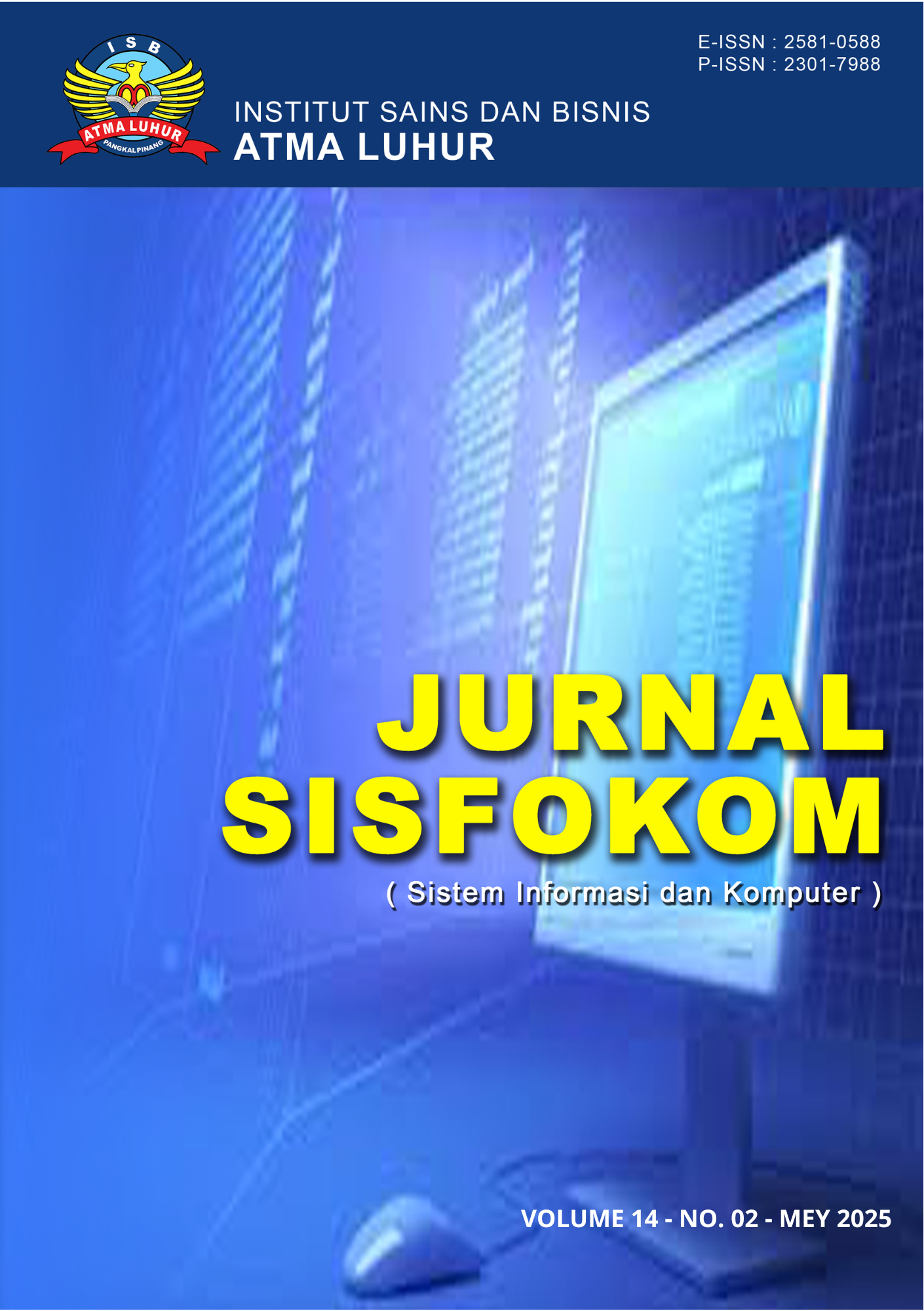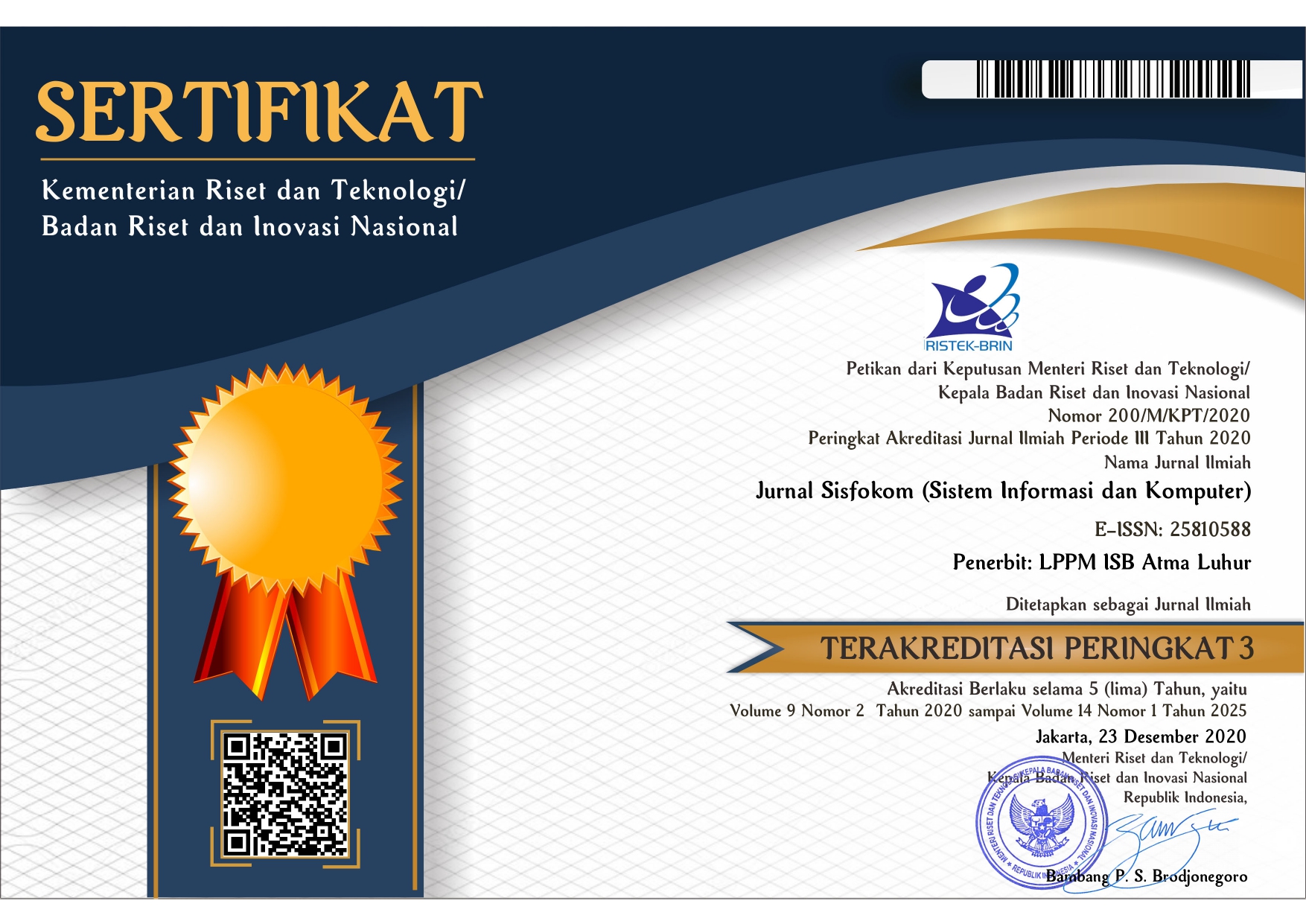The Role of Social Influence and Security Risk in Shaping Intention to Use Ride-Hailing in West Papua: A Theory of Planned Behavior Perspective
DOI:
https://doi.org/10.32736/sisfokom.v14i2.2333Keywords:
Service Performance, User Intention, Ride-hailing, User Behavior, Theory of Planned BehaviorAbstract
This study explores the adoption of ride-hailing services in West Papua, a developing region in Indonesia, where concerns about service performance and security risks influence user decisions. Guided by the Theory of Planned Behavior (TPB), the research examines how service performance, social influence, and perceived security risks affect users’ behavioral intention and actual usage. A total of 158 valid responses were collected through a quantitative survey, and data were analyzed using Partial Least Squares Structural Equation Modeling (PLS-SEM). Findings reveal that service effectiveness and social influence significantly influence behavioral intention, while efficiency and certainty do not. Additionally, certainty, effectiveness, and behavioral intention strongly affect user behavior. The model demonstrates moderate explanatory power with R² values of 0.561 for behavioral intention and 0.600 for user behavior. These results suggest that enhancing perceived service effectiveness and leveraging social influence can encourage adoption in regions with limited digital infrastructure. The study contributes to understanding technology acceptance in underdeveloped areas and offers practical insights for ride-hailing providers aiming to improve user trust and engagement.References
D. I. Inan et al., “Technology anxiety and social influence towards intention to use of ride-hailing service in Indonesia,” Case Stud. Transp. Policy, vol. 10, no. 3, pp. 1591–1601, 2022, doi: 10.1016/j.cstp.2022.05.017.
B. Bustami and R. Laksamana, “Transformasi Transportasi Tradisional (Offline) ke Transportasi Online Sebagai Solusi Bagi Pengguna di Kota Pontianak,” J. Ekon. Bisnis dan Kewirausahaan, vol. 8, no. 3, p. 194, 2019, doi: 10.26418/jebik.v8i3.29404.
N. Chasanah, D. Ferriswara, and L. Listyawati, “Analysis of the Quality of Maxim and Indrive Online Motorcycle Taxi Services for Students of Dr . Soetomo University Surabaya,” Int. J. Multicult. Multireligious Underst., vol. 11, no. 1, pp. 270–279, 2024, doi: http://dx.doi.org/10.18415/ijmmu.v11i1.5285.
B. D. Mardjani, S. L. H. V. J. Lapian, and M. Mangantar, “Pengaruh Harga, Promosi Dan Kualitas Layanan Terhadap Kepuasan Konsumen Pada Transportasi Online (Studi Kasus Gojek Dan Maxim Di Kota Manado),” J. EMBA J. Ris. Ekon. Manajemen, Bisnis dan Akunt., vol. 11, no. 1, pp. 942–952, 2023, doi: 10.35794/emba.v11i1.46658.
G. Valentino Aji, U. Pembangunan Jaya Alamat, J. Cendrawasih Raya Bintaro Jaya, S. Baru, K. Ciputat, and K. Tangerang Selatan, “Pengaruh Kualitas Pelayanan terhadap Minat Beli Ulang pada Transportasi Online Maxim Universitas Pembangunan Jaya Handito Lava Daenova,” J. Sains Student Res., vol. 1, no. 2, pp. 370–379, 2023, [Online]. Available: https://doi.org/10.61722/jssr.v1i2.162
A. V. Utami and D. S. S. T, “Analisis Faktor Pendorong Niat Menggunakan Grab Factor Analysis Affecting Behavioral Intention To Use Grab,” eProceedings Manag., vol. 7, no. 2, pp. 3396–3405, 2020, [Online]. Available: https://openlibrarypublications.telkomuniversity.ac.id/index.php/management/article/view/13444%0Ahttps://openlibrarypublications.telkomuniversity.ac.id/index.php/management/article/download/13444/12987
J. F. Tunner, E. Day, and M. R. Crask, “Protection motivation theory,” J. Bus. Res., vol. 19, no. 4, pp. 267–276, 1989, doi: 10.1016/0148-2963(89)90008-8.
M. S. S. Siqueira, P. O. Nascimento, and A. P. Freire, “Reporting Behaviour of People with Disabilities in relation to the Lack of Accessibility on Government Websites: Analysis in the light of the Theory of Planned Behaviour,” Disabil. CBR Incl. Dev., vol. 33, no. 1, pp. 52–68, 2022, doi: 10.47985/dcidj.475.
D. Nugraha, G. Putra, and S. T. Raharjo, “Analisis Pengaruh Kemudahan Penggunaan, Kualitas Layanan, Dan Persepsi Manfaat Terhadap Loyalitas Pengguna Dengan Kepuasan Pengguna Sebagai Variabel Intervening (Studi pada Pengguna Aplikasi Grab di Kota Semarang),” Diponegoro J. Manag., vol. 10, no. 6, pp. 1–15, 2021, [Online]. Available: http://ejournal-s1.undip.ac.id/index.php/dbr
H. Anjani, D. I. Inan, R. Juita, M. Sanglise, I. Engineering, and U. Papua, “Towards spatial information system adoption using extended tam and is success model,” vol. X, no. 4, 2024.
S. R. Rodiah and I. S. Melati, “Pengaruh Kemudahan Penggunaan, Kemanfaatan, Risiko, dan Kepercayaan terhadap Minat Menggunakan E-wallet pada Generasi Milenial Kota Semarang,” J. Econ. Educ. Entrep., vol. 1, no. 2, p. 66, 2020, doi: 10.31331/jeee.v1i2.1293.
D. Irawan and M. W. Affan, “Pengaruh Privasi dan Keamanan Terhadap Niat Menggunakan Payment Fintech,” J. Kaji. Akunt., vol. 4, no. 1, p. 52, 2020, doi: 10.33603/jka.v4i1.3322.
I. Lestari and R. S. Hamid, “Analisis Tingkat Kepercayaan Dan Kepuasan Pelanggan Terhadap Niat Untuk Menggunakan Kembali Layanan Transportasi Online Di Era Pandemi Covid-19,” Equilib. J. Ilm. Ekon. Manaj. dan Akunt., vol. 9, no. 1, pp. 27–35, 2020, doi: 10.35906/je001.v9i1.482.
M. Febriani, A. Rachmadi, and A. D. Herlambang, “Pengaruh Golongan Usia Pengguna dari Layanan Ride-Hailing terhadap Faktor-Faktor Penggunaan Teknologi berdasarkan Unified Theory of Acceptance and Use of Technology,” vol. 1, no. 1, 2023.
A. Amaranggana, “Pengaruh Antara Persepsi Kualitas Pelayanan dengan Loyalitas Konsumen Profesi Karyawan pada Penggunaan Jasa Ojek Online,” 2024, [Online]. Available: https://repository.unair.ac.id/130904/1/ARTIKEL JURNAL_112011133101_AMANTA AMARANGGANA.pdf
N. Bagus Sadita, “Analisis Efektivitas Iklan Transportasi Online Grab Di Kabupaten Jember,” pp. 1–7, 2019, [Online]. Available: http://repository.unmuhjember.ac.id/6428/
I. Samberi, D. I. Inan, R. N. Wurarah, R. Juita, and M. Sanglise, “Analysis of the Adoption Level of Qris in West Papua: The Roles of Self-Efficacy, Personal Innovativeness, and Privacy Concern,” Jutisi J. Ilm. Tek. Inform. dan Sist. Inf., vol. 13, no. 1, p. 346, 2024, doi: 10.35889/jutisi.v13i1.1823.
A. D. Oktavia, D. I. Inan, R. N. Wurarah, and O. A. Fenetiruma, “Analisis Faktor-faktor Penentu Adopsi E-Wallet di Papua Barat: Extended UTAUT 2 dan Perceived Risk,” MALCOM Indones. J. Mach. Learn. Comput. Sci., vol. 4, no. 2, pp. 587–600, 2024, doi: 10.57152/malcom.v4i2.1277.
C. F. Risdiyanto, D. I. Inan, R. N. Wurarah, and O. A. Fenetiruma, “Analisis Faktor-faktor Pendukung dan Penghambat Beralih Mengadopsi Mobile Banking di Papua Barat Memanfaatkan PLS-SEM dan Perspektif Status Quo Bias,” MALCOM Indones. J. Mach. Learn. Comput. Sci., vol. 4, no. 2, pp. 637–646, 2024, doi: 10.57152/malcom.v4i2.1289.
D. Supriadi, A. H. Iman, and Y. Saputra, “Studi Intensi Pembelian Kendaraan Listrik pada Generasi-Z: Pendekatan Teori Perilaku Terencana yang diperluas,” EKOMABIS J. Ekon. Manaj. Bisnis, vol. 5, no. 01, pp. 83–98, 2024, doi: 10.37366/ekomabis.v5i01.1444.
N. Wanma, D. I. Inan, and L. Y. Baisa, “Evaluasi User Experience Dan User Interface Aplikasi Laporkitong Dengan End User Computing Satisfaction,” Jutisi J. Ilm. Tek. Inform. dan Sist. Inf., vol. 13, no. 1, p. 304, 2024, doi: 10.35889/jutisi.v13i1.1789.
N. Kock and P. Hadaya, “Minimum sample size estimation in PLS-SEM: The inverse square root and gamma-exponential methods,” Inf. Syst. J., vol. 28, no. 1, pp. 227–261, 2018, doi: 10.1111/isj.12131.
J. F. Hair, M. Sarstedt, L. Hopkins, and V. G. Kuppelwieser, “Partial least squares structural equation modeling (PLS-SEM): An emerging tool in business research,” Eur. Bus. Rev., vol. 26, no. 2, pp. 106–121, 2014, doi: 10.1108/EBR-10-2013-0128.
D. I. Inan et al., “Because Follower Experience Matters: The Continuance Intention to Follow Recommendation of the Influencer,” Hum. Behav. Emerg. Technol., vol. 2022, no. [1] D. I. Inan et al., “Because Follower Experience Matters: The Continuance Intention to Follow Recommendation of the Influencer,” Hum. Behav. Emerg. Technol., vols. 2022, 2022, doi: 10.1155/2022/3684192., 2022, doi: 10.1155/2022/3684192.
Y. N. Hajiku Faradila, Niswatin, “Pengaruh Marketplace Maxim Terhadap Tingkat Penjualan Pada UMKM di Kota Gorontalo Abstrak,” vol. 11, no. 1, pp. 1–9, 2025.
D. I. Inan et al., “Service quality and self-determination theory towards continuance usage intention of mobile banking,” J. Sci. Technol. Policy Manag., vol. 14, no. 2, pp. 303–328, 2023, doi: 10.1108/JSTPM-01-2021-0005.
E. R. Oetami and H. Sulistyo, “Penggunaan Tik Pada Proyek Perubahan Pendidikan Dan Pelatihan Kepemimpinan Untuk Meningkatkan Perilaku Inovatif: Studi Kasus Terhadap Pemerintah Kabupaten Kotawaringin Barat,” Anterior J., vol. 23, no. 2, pp. 153–168, 2024, doi: 10.33084/anterior.v23i2.7127.
P. W. Handayani, R. A. Nurahmawati, A. A. Pinem, and F. Azzahro, “Switching Intention from Traditional to Online Groceries Using the Moderating Effect of Gender in Indonesia,” J. Food Prod. Mark., vol. 00, no. 00, pp. 425–439, 2020, doi: 10.1080/10454446.2020.1792023.
Y. Wang, J. Gu, S. Wang, and J. Wang, “Understanding consumers’ willingness to use ride-sharing services: The roles of perceived value and perceived risk,” Transp. Res. Part C Emerg. Technol., vol. 105, no. May, pp. 504–519, 2019, doi: 10.1016/j.trc.2019.05.044.
D. Nguyen, “Understanding Perceived Enjoyment and Continuance Intention in Mobile Games,” ICFAI J. Syst., p. 58, 2015, [Online]. Available: http://epub.lib.aalto.fi/fi/ethesis/pdf/14000/hse_ethesis_14000.pdf
J. H. Kandami, D. I. Inan, R. Juita, L. Y. Baisa, M. Sanglise, and M. Indra, “Development and Evaluation of Android-based Infrastructure Rental Application: A Design Science Research Approach,” J. Teknol. dan Manaj. Inform., vol. 10, no. 1, pp. 36–47, 2024, doi: 10.26905/jtmi.v10i1.13004.
P. E. Setiawati, D. I. Inan, R. N. Wurahrah, R. Juita, and M. Sanglise, “How the perceived enjoyment effect m-payment adoption in west papua province: delone and mclean information systems success model,” vol. 9, no. 3, pp. 1494–1505, 2024.
M. Patabang, D. I. Inan, A. Matualage, and M. Indra, “The Moderation Effect of Technology Anxiety on Digital Transformation Readiness in Public Universities : An Organizational Readiness Approach,” vol. 10, no. 2, pp. 59–70, 2024.
W. Reza, F. Jabnabillah, and A. S. Anggraeni, “Structural Equation Modeling Pada Adopsi Sistem Informasi Akuntansi Berbasis E-Commerce Menggunakan UTAUT2,” Value J. Manaj. dan Akunt., vol. 18, no. 1, pp. 199–214, 2023, doi: 10.32534/jv.v18i1.3886.
P. Tam et al., “1) , 2) , 3) 1,” vol. 08, no. 01, pp. 1–9, 2024.
D. Wardani, “Niat Pengguna Fintech Sistem Pembayaran pada Kalangan Milenium Masa Pandemi Covid-19,” J. Sist. Inf. Bisnis, vol. 3, no. 2, pp. 40–53, 2022.
L. Moreno, B. Requero, D. Santos, B. Paredes, P. Briñol, and R. E. Petty, “Attitudes and attitude certainty guiding pro-social behaviour as a function of perceived elaboration,” Eur. J. Soc. Psychol., vol. 51, no. 6, pp. 990–1006, 2021, doi: 10.1002/ejsp.2798.
Downloads
Published
Issue
Section
License

This work is licensed under a Creative Commons Attribution 4.0 International License.
The copyright of the article that accepted for publication shall be assigned to Jurnal Sisfokom (Sistem Informasi dan Komputer) and LPPM ISB Atma Luhur as the publisher of the journal. Copyright includes the right to reproduce and deliver the article in all form and media, including reprints, photographs, microfilms, and any other similar reproductions, as well as translations.
Jurnal Sisfokom (Sistem Informasi dan Komputer), LPPM ISB Atma Luhur, and the Editors make every effort to ensure that no wrong or misleading data, opinions or statements be published in the journal. In any way, the contents of the articles and advertisements published in Jurnal Sisfokom (Sistem Informasi dan Komputer) are the sole and exclusive responsibility of their respective authors.
Jurnal Sisfokom (Sistem Informasi dan Komputer) has full publishing rights to the published articles. Authors are allowed to distribute articles that have been published by sharing the link or DOI of the article. Authors are allowed to use their articles for legal purposes deemed necessary without the written permission of the journal with the initial publication notification from the Jurnal Sisfokom (Sistem Informasi dan Komputer).
The Copyright Transfer Form can be downloaded [Copyright Transfer Form Jurnal Sisfokom (Sistem Informasi dan Komputer).
This agreement is to be signed by at least one of the authors who have obtained the assent of the co-author(s). After submission of this agreement signed by the corresponding author, changes of authorship or in the order of the authors listed will not be accepted. The copyright form should be signed originally, and send it to the Editorial in the form of scanned document to sisfokom@atmaluhur.ac.id.









